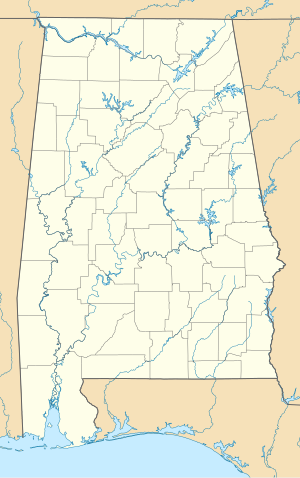Wilson Dam, Alabama
| Wilson Dam, Alabama | |||||||
|---|---|---|---|---|---|---|---|
|
|||||||
|
|
|||||||
| Coordinates | 34 ° 48 '3 " N , 87 ° 37' 33" W | ||||||
| Data on the structure | |||||||
| Lock type: | Gravity dam | ||||||
| Construction time: | 1918-1924 | ||||||
| Height of the barrier structure : | 41 m | ||||||
| Crown length: | 1,384 m | ||||||
| Power plant output: | 663 MW | ||||||
| Operator: | Tennessee Valley Authority (TVA) | ||||||
| Data on the reservoir | |||||||
| Water surface | 62.7 km² | ||||||
| Reservoir length | 25.7 km | ||||||
| Maximum depth | 27 m (mean depth 12 m) | ||||||
| Total storage space : | 790 million m³ | ||||||
The dam Wilson ( English Wilson Dam ) is a dam with hydroelectric power plant in the state of Alabama , USA . It dams the Tennessee River to a reservoir (English Wilson Lake ). The associated run-of-river power plant has an output of 663 megawatts ; it is the seventh power plant in the chain of nine hydropower plants on the Tennessee River, a left tributary of the Ohio River . The Tennessee River forms the border between Lauderdale and Colbert Counties at this point . The dam is located between the small towns of Florence and Muscle Shoals .
history
During the First World War , the National Defense Act of 1916 was enacted in the United States . a. provided for the construction of two nitrate factories for the production of explosives. Muscle Shoals was chosen as the location for the factories because of the existing hydropower potential to supply the two factories with the necessary electricity.
The United States Army Corps of Engineers (USACE) was commissioned to build the hydropower plant . Construction work began in 1918. They were completed in 1926 (or 1924). The building named after President Woodrow Wilson was at the time of completion the hydropower plant with the largest installed capacity in the world.
In the 1920s, Henry Ford submitted an offer to buy the power plant for $ 5 million . This met opposition from Senator George W. Norris , who worked to ensure that the government remained in control. He suggested that the power station should be part of a project to use hydropower on the Tennessee River. President Roosevelt adopted Senator Norris' ideas as part of the New Deal . In May 1933, the Tennessee Valley Authority (TVA) was established. The TVA acquired the power plant in the same year.
In November 1966, the dam was granted National Historic Landmark status and was listed as a structure on the National Register of Historic Places .
Plant parts
Barrier structure
The barrier is a concrete gravity dam approximately 41 m (137 ft ) high . The machine house is on the far left, followed by a weir system with 58 weir fields and 2 lock systems on the far right. The total length is 1,384 m (4,541 ft) or 1,482 m (4,862 ft). At the base, the dam is 32 m (105 ft) or 48 m (160 ft) wide.
The dam was designed in the neoclassical style .
Reservoir
In full back- up extending Wilson Lake over an area of approximately 62.7 square kilometers (15,500 acres ) and holds 790 million cubic meters (640 200 acre-feet ) of water. The length of the reservoir is 25.7 km (16 miles ). The average depth is 12 m (40 ft) and the maximum is 27 m (90 ft). The reservoir is known for the black bass .
power plant
The Wilson power plant has 18 (or 21) machines and an installed capacity of 630 (or 663) MW . The first machine in the power plant went into operation in September 1925. It is the TVA's most powerful run-of-river power plant. Only the Raccoon Mountain pumped storage plant has a higher installed capacity of 1,600 MW.
lock
On the right bank of the river is a lock that is 183 m (600 ft) long and 33 m (110 ft) wide. There is also another lock system, consisting of 2 smaller locks. An average of 3,700 ships pass through the locks in a year. The locks are operated by the USACE.
Others
The total cost of the project is given as $ 119 and 130 million , respectively.
Individual evidence
- ↑ a b c d e f g h i j k l m n Wilson Dam and Reservoir. Encyclopedia of Alabama, accessed April 9, 2016 .
- ↑ a b c d e f g h i j Wilson. Tennessee Valley Authority (TVA), accessed April 9, 2016 .
- ↑ a b c d e f g h i j Wilson Navigation Lock. USACE , accessed April 9, 2016 .
-
↑ Listing of National Historic Landmarks by State: Alabama. National Park Service , accessed April 1, 2020.
Wilson Dam on the National Register Information System. National Park Service , accessed April 1, 2020. - ↑ a b Wilson Lake Alabama. www.wilsonlake.info, accessed on April 12, 2016 (English).

